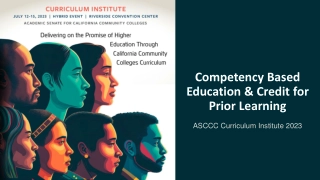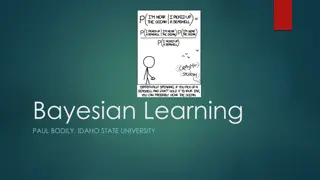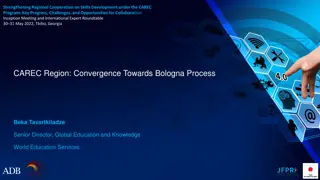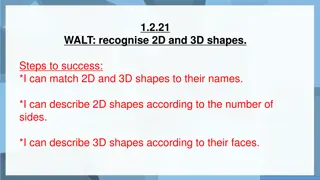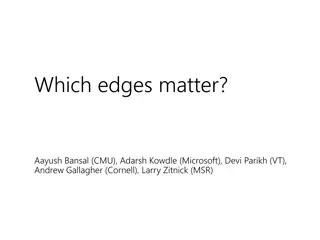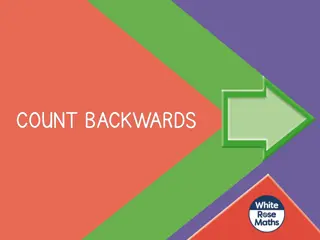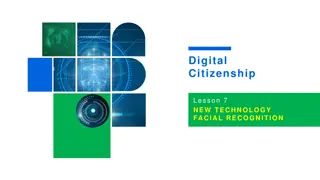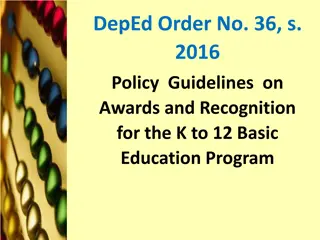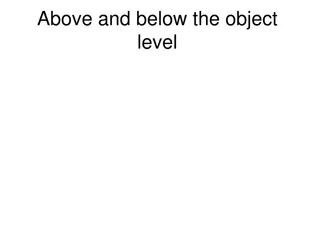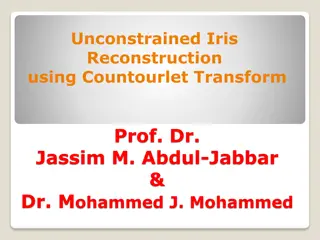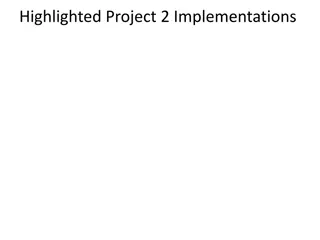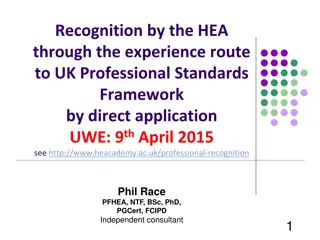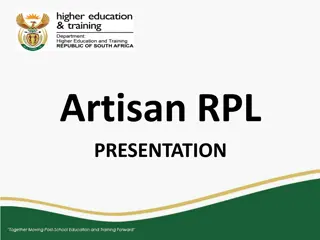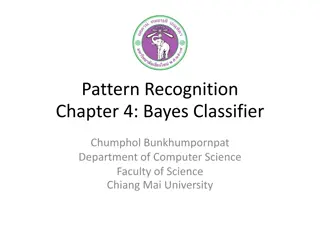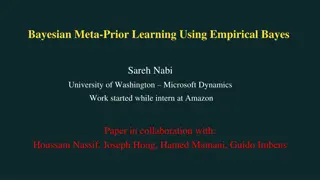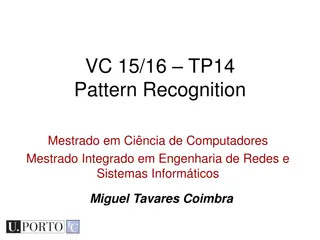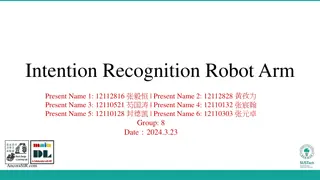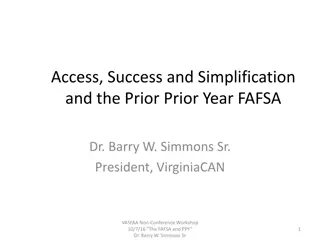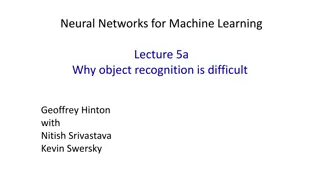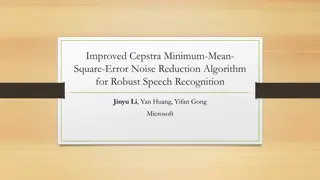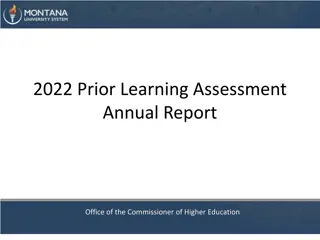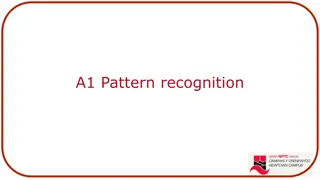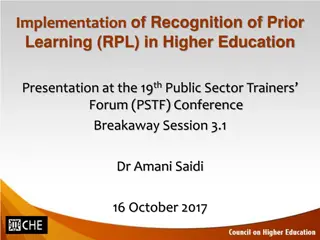Competency-Based Education & Credit for Prior Learning
Join this session to learn about proposed legislative updates and how colleges can provide students with opportunities for Credit for Prior Learning (CPL) through work-based learning and direct assessment of mastery.
2 views • 48 slides
Employee Recognition
Learn the importance of recognizing employee achievements to motivate and retain top talent. Explore various recognition methods and their impact on employee performance and company success. Discover tips and examples to implement an effective recognition program. Popular
0 views • 22 slides
Exploring AGImageAI: Enhancing Image Recognition with Artificial Intelligence
AGImageAI, developed by AlpineGate, is a cutting-edge image recognition software leveraging AI techniques to analyze various industries. AlpineGate, based in San Francisco, specializes in innovative solutions for image interpretation. Albert, the AI assistant, provides helpful information to users,
22 views • 21 slides
Practically Adopting Human Activity Recognition
Cutting-edge research in Human Activity Recognition (HAR) focuses on practical adoption at scale, leveraging labeled and unlabeled data for inference and adaptation. Prior works explore models like LIMU-BERT and address challenges in combating data heterogeneity for feature extraction.
0 views • 35 slides
Energy Wheel & Hazard Recognition Toolbox Talk
Hazard recognition is crucial for safety in all activities. Hazards can range from gravity and motion to mechanical and chemical risks. Failure to identify hazards can lead to incidents, making tools like the Energy Wheel key for improving recognition. The Energy Wheel enhances hazard recognition by
2 views • 10 slides
Understanding Bayesian Learning in Machine Learning
Bayesian learning is a powerful approach in machine learning that involves combining data likelihood with prior knowledge to make decisions. It includes Bayesian classification, where the posterior probability of an output class given input data is calculated using Bayes Rule. Understanding Bayesian
0 views • 17 slides
Unveiling the World of Facial Recognition Technology
Explore the world of facial recognition technology and delve into its benefits, risks, and impact on privacy. Understand key vocabulary, essential questions, and learning objectives surrounding this AI technology. Dive into discussions on unlocking devices with facial recognition and ponder the impl
0 views • 21 slides
Advancing Regional Cooperation on Skills Development in the CAREC Program
Strengthening Regional Cooperation on Skills Development under the CAREC Program is crucial for progress in the region. Challenges and opportunities for collaboration were discussed at the Inception Meeting and International Expert Roundtable in Tbilisi, Georgia. With 48 years of expertise, World Ed
0 views • 14 slides
Shapes Recognition Activities for Students
Explore various 2D and 3D shape recognition activities including matching shapes to names, identifying shapes based on sides and faces, and sorting shapes into categories. Engage in fluency exercises to name and match shapes, reasoning challenges, and problem-solving tasks to enhance shape recogniti
0 views • 12 slides
Understanding the Importance of Different Edge Types in Image Recognition
This content delves into the significance of various edge types in image recognition, exploring the impact of edges such as albedo, depth, surface normal, and shadow on the recognition process. Researchers have studied the effects of different edge types through works dating back to the 1960s, aimin
0 views • 31 slides
Counting and Number Recognition Activities
Engage in a variety of counting and number recognition activities, including identifying numbers, counting backwards, and identifying missing numbers on number tracks. These fun exercises encourage children to practice their counting skills and improve their number recognition abilities.
0 views • 13 slides
Understanding Prior Beliefs and Eliciting Expert Opinions in Parameter Estimation
Prior beliefs play a crucial role in estimating parameters of interest before observing events. They can be elicited from sources like meta-analyses, literature, and expert opinions. Experts' beliefs are often measured using Beta or Normal distributions for different outcomes. Eliciting prior belief
0 views • 22 slides
Exploring Facial Recognition Technology in Digital Citizenship
Dive into the world of facial recognition technology with a focus on digital citizenship. Learn about its benefits, risks, trends, and potential invasion of privacy. Delve into discussions on the use of facial recognition in various devices and its implications for security and convenience, using re
0 views • 11 slides
Bayesian Inference with Beta Prior in Coin Toss Experiment
Suppose you have a Beta(4,.4) prior distribution on the probability of a coin yielding a head. After spinning the coin ten times and observing fewer than 3 heads, the exact posterior density is calculated. The posterior distribution is plotted and analyzed, showing how the prior influences the updat
7 views • 15 slides
Spectroscopy and Pattern Recognition in Pharmaceutical Analysis
Understanding spectroscopy and pattern recognition in pharmaceutical analysis is crucial for interpreting 1H NMR spectra. Specific splitting patterns indicate the presence of various functional groups like ethyl, isopropyl, and tert-butyl. Recognizing these patterns aids in identifying compounds eff
3 views • 51 slides
Automatic Recognition of Higher Education Qualifications Treaty Summary
Importance of automatic recognition of qualifications in higher education has been emphasized, leading to initiatives like the Treaty on Automatic Recognition of Higher Education Qualifications by Baltic and Benelux states. This treaty aims to enhance mutual trust, transparent recognition, and contr
1 views • 8 slides
Innovative Learning Management System - LAMS at Belgrade Metropolitan University
Belgrade Metropolitan University (BMU) utilizes the Learning Activity Management System (LAMS) to enhance the learning process by integrating learning objects with various activities. This system allows for complex learning processes, mixing learning objects with LAMS activities effectively. The pro
4 views • 16 slides
Evaluating Bias in Value-Added Models Using Prior Scores
Outcome-based value-added (VA) models are commonly used to assess productivity in various fields. This study explores the use of prior scores to evaluate bias in VA estimates, focusing on the correlation between current teacher VA and lagged outcomes. The analysis highlights the sensitivity of balan
0 views • 38 slides
Tactical Field Care - Shock Recognition and Management
Tactical Field Care emphasizes the importance of shock recognition and prompt intervention to prevent casualties on the battlefield. Understanding the signs, symptoms, and management steps of shock, particularly in trauma cases with life-threatening bleeding, is crucial for medical personnel. This m
0 views • 18 slides
Enhancing Learning Through Awards and Recognition Programs
This policy guideline emphasizes the importance of awards and recognition in creating a positive learning environment, boosting student morale, and motivating high performance. It focuses on providing equal opportunities for learners to excel, recognizing their unique strengths, and promoting studen
0 views • 53 slides
Understanding Invariance in Posterior Distributions
Exploring the insensitivity of posterior distributions to variations in prior distributions using a Poisson model applied to pancreas data. The analysis involves calculating posterior mean and standard deviation with different Gamma prior distributions. Results showcase minimal change in outcomes ac
0 views • 7 slides
Understanding Levels of Object Recognition in Computational Models
Explore the levels of object recognition in computational models, from single-object recognition to recognizing local configurations. Discover how minimizing variability aids in interpreting complex scenes and the challenges faced by deep neural networks in achieving human-level recognition on minim
0 views • 29 slides
Enhancing Iris Recognition with Circular Contourlet Transform
Iris recognition is a reliable biometric identification method due to the iris's unique properties. By incorporating the Circular Contourlet Transform (CCT) into the classical iris recognition algorithm, the feature extraction process can be enhanced to improve recognition rates under unconstrained
0 views • 14 slides
Exploring Visual Vocabulary Trees for Image Recognition
In this detailed content, the implementation of Vocabulary Trees for image recognition is discussed. The structure's complexity, efficiency in processing a large number of images, and issues related to instance recognition are explored. The text delves into the benefits of using vocabulary trees, ch
0 views • 27 slides
Cesarean Delivery Timing Guidelines for Women with Prior Uterine Scars
Society for Maternal Fetal Medicine provides cesarean delivery timing recommendations for women with prior uterine scars. For those with a history of classical cesarean, the risk of uterine rupture guides the timing of repeat cesarean. Similarly, women with prior myomectomy should plan delivery betw
0 views • 10 slides
Understanding Entrepreneurial Opportunity Recognition
Entrepreneurial opportunity recognition is crucial for starting a successful business. It involves identifying favorable circumstances that create the need for a new product, service, or business idea. Recognizing opportunities can be done by observing trends, solving problems, and finding gaps in t
0 views • 17 slides
Understanding HEA Professional Recognition in the UK Higher Education Sector
Recognition by the Higher Education Academy (HEA) through the experience route to the UK Professional Standards Framework (UKPSF) is a valuable achievement for higher education practitioners. This presentation by Phil Race and Sally Brown highlights the benefits of HEA recognition, the evolving syst
0 views • 79 slides
Advancing Recognition of Prior Learning for Artisan Trade Workers
Artisan RPL Presentation highlights the socio-economic rationale behind the Artisan RPL program to provide formal recognition for semi-skilled trade workers. The project aims to address past imbalances, establish a clear pathway to trade tests, and standardize ARPL practices across sectors. Various
0 views • 9 slides
Understanding Bayes Classifier in Pattern Recognition
Bayes Classifier is a simple probabilistic classifier that minimizes error probability by utilizing prior and posterior probabilities. It assigns class labels based on maximum posterior probability, making it an optimal tool for classification tasks. This chapter covers the Bayes Theorem, classifica
0 views • 24 slides
Bayesian Meta-Prior Learning Using Empirical Bayes: A Framework for Sequential Decision Making Under Uncertainty
Explore the innovative framework proposed by Sareh Nabi at the University of Washington for Bayesian meta-prior learning using empirical Bayes. The framework aims to optimize ad layout and classification problems efficiently by decoupling learning rates of model parameters. Learn about the Multi-Arm
0 views • 27 slides
Face Recognition: A Comprehensive Literature Survey
This literature survey delves into the importance and challenges of face recognition technology, covering topics such as biometrics, human face recognition, variations in pose and illumination, early and modern approaches, as well as the evaluation of face recognition systems. The need for face reco
0 views • 30 slides
Tau Beta Sigma Sorority Jewelry Collection - Spring 2013
Explore the exquisite collection of Tau Beta Sigma sorority jewelry, including the Prospective Member Pin, TB Recognition Pin, Enameled Recognition Pin, Crown Pearl Badge, Official Key, Recognition Bar, and Life Member Pin. Each piece holds special significance within the sorority, symbolizing commi
0 views • 11 slides
Understanding Pattern Recognition in Computer Science
Dive into the world of pattern recognition, where data is analyzed to make decisions and identify features. Explore statistical pattern recognition, classifiers, and the process of recognizing patterns in images. Learn how computers see and interpret visual data, and the challenges of representing k
0 views • 43 slides
Assistive System Design for Disabilities with Multi-Recognition Integration
Our project aims to create an assistive system for individuals with disabilities by combining IMU action recognition, speech recognition, and image recognition to understand intentions and perform corresponding actions. We use deep learning for intent recognition, gesture identification, and object
0 views • 14 slides
Understanding the Impact of Prior-Prior Year FAFSA Implementation
The Prior-Prior Year (PPY) FAFSA implementation has brought significant changes to the financial aid process for colleges and universities. This article discusses the utilization of PPY, its implications on aid processing calendars, admissions deadlines, and decision-making for educational instituti
0 views • 30 slides
Challenges in Object Recognition for Machine Learning
Understanding the complexities of object recognition is crucial in machine learning. Real scenes present challenges like cluttered backgrounds, varied lighting, deformation, and affordances. Viewpoint changes and input dimension hopping further complicate recognition tasks. Different approaches, suc
0 views • 30 slides
Improved Cepstra Minimum-Mean-Square-Error Noise Reduction Algorithm for Robust Speech Recognition
This study introduces an improved cepstra minimum-mean-square-error noise reduction algorithm for robust speech recognition. It explores the effectiveness of conventional noise-robust front-ends with Gaussian mixture models (GMMs) and deep neural networks (DNNs). The research demonstrates the benefi
0 views • 43 slides
Montana University System Prior Learning Assessment Report 2022
The 2022 Prior Learning Assessment Annual Report from the Office of the Commissioner of Higher Education in the Montana University System showcases various ways students can earn credits through standardized tests, portfolio assessments, military credits, and experiential learning. The report highli
0 views • 7 slides
Understanding Pattern Recognition in Computational Thinking
Pattern recognition in computational thinking involves identifying common elements, interpreting differences, and predicting based on patterns. It helps simplify complex problems by recognizing similarities and characteristics shared among them. Through repetition and algorithmic processes, patterns
0 views • 6 slides
Overview of Recognition of Prior Learning (RPL) in Higher Education
This presentation at the 19th Public Sector Trainers Forum (PSTF) Conference delves into the concept of Recognition of Prior Learning (RPL) in higher education. It explores the principles, key concepts, purposes, and legislative context of RPL, highlighting its importance in facilitating access, mob
0 views • 18 slides
